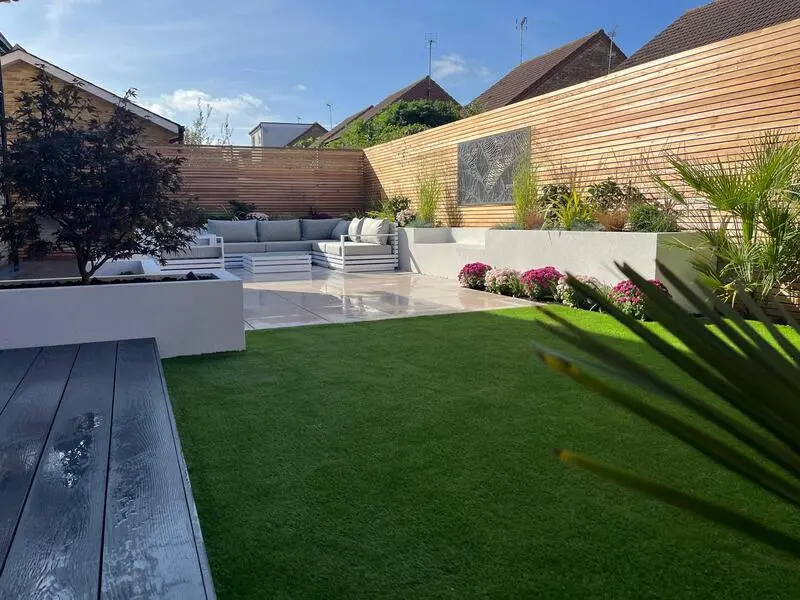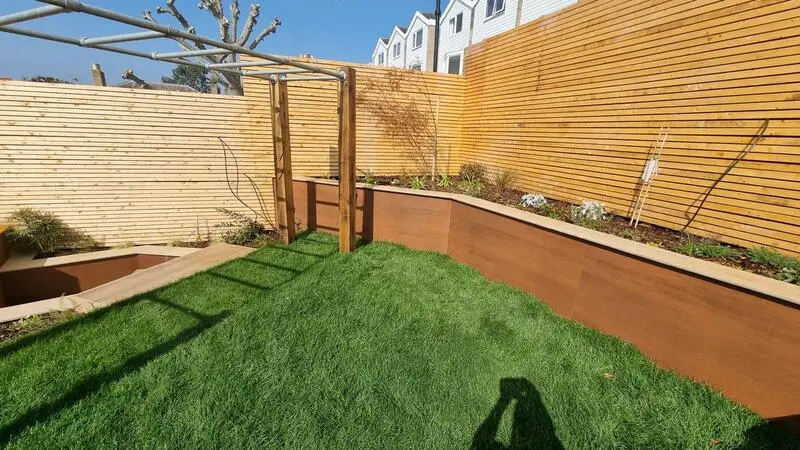A great garden can change the way your home looks. Landscaping is much more than planting a few flowers and arranging some chairs. It’s creating a design that invites positivity, order, and peace to a space. Creating a landscaped area is important whether you have a small garden or a big backyard. We hope this guide can help you understand the value and beauty of garden landscaping and creating a space you can manage with ease.

What is Garden Landscaping?
Garden landscaping is the planning, design, and arrangement of the outdoor spaces of your home. It combines art and Nature to create a garden that is functional and strikingly attractive.
A landscaped garden consists of plan elements like flowers and grass, as well as constructed features such as pathways, trees, stones, and other decorations like chairs, lighting and water features.
Landscaping can be classified into the following two categories:
- Soft landscaping — Interactions with Nature: plants, grass and trees.
- Hard landscaping — Interactions with Man: tiles, fences, decks, stones and lighting.
A well-designed garden makes use of both soft and hard landscaping.
The Importance of Landscaping Your Garden
Improving the way your garden looks is not the only reason landscaping is important. Here are a few of the other benefits it provides:
- Adds aesthetic value – A well-landscaped garden is beautiful, inviting, and peaceful.
- Improves the value of the property – Homes with landscaped gardens are worth more.
- Enhances the ecosystem – Plants clean the air and attract birds. More chewers and pollen dispensers.
- Gets rid of stress – Spending time in green places eases the mind.
- Spends time outside – Gives the space for Relaxation, Play, and large gatherings.
How to Landscape a Garden in 8 Steps
The procedure for designing and constructing a garden landscape must be followed step by step.
Step 1: Study Your Garden Space
Before you begin thinking about your garden design, evaluate your garden space.
- Measure the area and write down the size.
- Identify the sun and shade locations.
- Characterise the soul. I.e. clay, sandy or loam.
- Check the site for water saturation after a rainfall.
- Draw a simple diagram of your garden: existing trees, walls or pathways. This will help with planning in the future.
Step 2: Decide on a Garden Style
All great gardens have a style or theme. Choose one that complements your taste and the design of your home.
Every garden has its unique style. Here are a few examples:
- Modern Gardens focus on simplicity. They have clean lines and geometric designs with an orderly arrangement of a few selected plants.
- Cottage Gardens are more playful and cheerful, with an arrangement of colourful flowers, curved garden paths, and rustic elements.
- Tropical Gardens are a feast for the eyes with bright plants, large leaves, and ample greenery.
- Japanese Gardens have an arrangement of stones, simple plants, and water features like ponds that create a serene and peaceful space.
- Formal Gardens are the most meticulous, with a symmetrical and balanced arrangement and evenly trimmed hedges.
Sticking to a single theme makes your garden more approachable and cohesive.
Step 3: Plan The Layout
After you select a style, the next step is to create a layout. Start by zoning the layout of your garden:

- Lawn area: Open space and greenery
- Flower beds: Seasonal blooms to beautify your landscape
- Pathways: Designed for easy walking access
- Seating area: Relaxing or dining
- Decorative corners: Fountains, rocks, or sculptures to add whimsy
Curves can help your garden avoid looking rigid or formal, and round lines can create a more flowing and organic look.
Step 4: Pathways and Borders
Pathways help connect the different areas and features of a garden, providing a much clearer and organised layout. They can be made of:
- Gravel or crushed stone
- Wood decks or stepping stones
- Brick or concrete pavers
Borders help to define the area of flower beds or lawns. You can use plants, stones, or metal edging for a clean look.
Step 5: Choose Plants and Trees
Selecting the right plants for your garden will enhance its beauty and vibrancy. You can achieve this with the right mix of the following:
- Trees: To achieve height and shade.
- Shrubs: For structure and greenery.
- Flowers: For added colour and scent.
- Groundcovers: To fill patches of bare soil.
- Climbing plants: To cover fences or trellises.
While interested in planting any of the above, consider important factors such as:
- Local climate and sunlight.
- Soil type.
- Water needs.
- Seasonal variety (mix of evergreens and flowering plants).
For easy maintenance, place plants with similar needs in the same section.
Step 6: Incorporate Hardscaping Elements
For your garden to have more beauty and functionality, you can incorporate:
- Patios or decks: For setting up outdoor seating.
- Fountains or ponds: For added soothing aesthetics.
- Rock gardens: To introduce texture and contrast.
- Lighting: Solar or LED for pathways and plants.
These will enhance the usability of your garden during the day and night.
Step 7: Set Up Irrigation and Drainage
In landscaping, managing water is vital, and here’s how to do it.
- To save water, install a drip irrigation system.
- Soil moisture can be retained with mulch.
- Finally, ensure that excess water drains away, preventing it from puddling and causing root rot.
Step 8: Add Finishing Touches
Once everything is planted and built, how about decorating your garden?
- Install some benches, swings, and hammocks for some relaxation.
- Planters and pots provide more colours and more interest.
- Garden ornaments and lanterns also add charm.
Don’t forget to trim and clean the garden regularly. It’ll help the garden sparkle.
Landscaping Ideas for Small Gardens
For small gardens, you can still do these small-space enhancing ideas:
- Install wall planters and other vertical gardening to save space.
- Light paving stones give an illusion of spaciousness.
- Adding mirrors will give the illusion of more space.
- Having one main focal point will help keep everything organised.
Landscaping Ideas for Large Gardens
You can also divide your larger space into functional sections.
- Designate areas for a lounge or patio, a vegetable garden, a children’s play area, and a rock or lawn garden.
- Create contrast with tall trees for natural shade and smaller plants or flowers.
- Curved paths will create an illusion of connectedness for larger spaces.
Overcrowding plants, not having a plan, poor drainage, and too many decorations are some of the biggest landscaping mistakes to avoid. Steering clear of these blunders allows your garden to remain in harmony in terms of attractiveness and effortless upkeep, too.
Frequently Asked Questions (FAQs)
What’s the difference between gardening and landscaping?
Gardening is the growing of plants and or flowers. Landscaping is the design and arrangement of living (plants) and non-living (rocks, buildings) elements.
Can I landscape my garden myself?
Certainly! With the right preparation and information, homeowners can landscape smaller gardens. For larger gardens or intricate designs, it’s best to hire a landscape designer.
How long does it take to landscape a garden?
Landscaping smaller gardens can take 1 to 2 weeks. Larger gardens that have features like ponds or patios can take 1 to 3 months.
When is the best time to landscape a garden?
Spring and autumn are the best seasons for landscaping because plants settle in better during these mild temperatures.
Does landscaping add value to a property?
Absolutely! A garden that is well landscaped can increase your property value by 10 to 20 per cent.
Conclusion
One of the best investments you could make for your home is garden landscaping. It increases the charm and tranquility of your outdoor space, while also making it functional. Designing a lasting garden is a piece of cake when you have a good plan, comprehend your garden, make appropriate plant selections, install paths and landscape features, and upkeep it.
Carefully considered landscaping will reconcile you to Nature and change your environment into your very own piece of Eden, no matter whether you are designing a limited space like a tiny indoor garden or a wide expanse.
